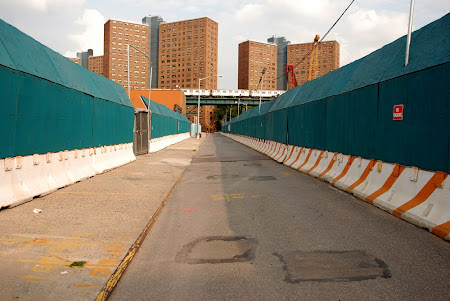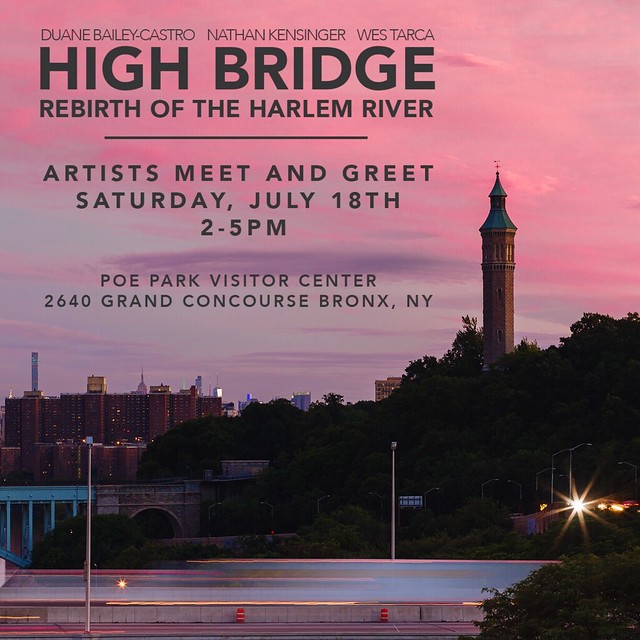The Demolition of Manhattanville

August 31, 2011 -
Not long ago, the streets of Manhattanville were lined with small businesses. Gas stations, auto body shops, parking garages and storage buildings stood alongside popular restaurants, creating a unique mixed-use neighborhood. Today, that neighborhood has largely been demolished. Businesses have been shuttered. Warehouses have been reduced to cracked bricks. In total, seventeen acres in the heart of this historic industrial valley will be destroyed and Manhattanville will be a construction site for the next two decades, as Columbia University completes its plan to build a $7 billion campus extension.
This past December, the state of New York won the final round in a six year battle against the last private property owners inside Columbia University's project footprint. The owners had been fighting against the state's decision to use eminent domain to seize their property and hand it over to the university. The battle went all the way to the United States Supreme Court, which ultimately refused to hear the property owners' appeal. "In all likelihood... the battle is over," the NY Times wrote after the decision, and since then the demolition of Manhattanville has proceeded quickly.
The blocks condemned by the university's plan already feel desolate and abandoned. Huge vacant lots are filled with dirt, debris and heavy equipment. Emptied buildings are marked by the symbols of planned demolition. A sinkhole idles in the middle of an unused road, clogged with trash. Sidewalks are inaccessible, streets lined with barricades. "The Manhattanville expansion will, by Columbia’s own estimates, displace 5,000 people," according to the Columbia Spectator, creating a temporary ghost town while the project is underway. Residents who remain in the area complain that a "rat epidemic" has been unleashed by construction activity, according to the Columbia Spectator, while others fear the swirling clouds of demolition dust will cause respiratory illness, according to DNAinfo, leading the university to buy air conditioners for at least one apartment tower.
A century ago, these empty streets teemed with horses. Manhattanville's long industrial history includes thriving dairy factories with stables that sent out "wagons to drop off thousands of bottles every morning to individual customers," according to the NY Times, alongside "factories producing lumber, paint, beer, dye and other materials." Columbia has already demolished at least one historic stable, and Manhattanville's industrial heritage will soon be consigned to the past. The majority of street traffic today is from yellow cabs refueling at the neighborhood's two remaining gas stations. They are scheduled to be torn down too.
If all goes according to plan, the Manhattanville campus will be completed by 2033. However, "of the 17 planned buildings on campus, the specific uses of only six have been determined," according to the Columbia Spectator, and in the meantime, the failing economy has led the Village Voice to ask "will NYC's college building boom bubble pop?" For now, Manhattanville's empty lots and demolished businesses wait for their promised transformation.
For more photo essays on neighborhoods endangered by eminent domain, please visit The Bloomberg Era, Part Two (2010), Manhattanville: Phase One (2008), The Iron Triangle (2008), and The Atlantic Yards (2007).






















Thanks for your article.
ReplyDeleteThat's the bad news. As someone who has spent over a decade researching, documenting and photographing the shards of Manhattanville's past, I'm obviously dismayed by Columbia's wholesale destruction of history. The fact that a 1997 study report out of the university's own Graduate School of Architecture, Planning & Preservation argued strongly in favor of preserving the area adds a whiff of cynicism to the wrecking dust.
But the good news (albeit delivered at a perverse price) is that the CU expansion issue has helped put Manhattanville back on the map, in the media and in people's conversations. CU's expansion footprint is only a portion of the historic Manhattanville neighborhood, not the sum of its parts.
Eric K. Washington
Author, "Manhattanville: Old Heart of West Harlem", Arcadia Images of America series, 2002
Curator, "Manhattanville: Hidden In Plain Sight", The City College of New York, 2004
Thanks for the pictures. I hate to be blunt, but in all honesty the old manhattanville was a waste of space. People were afraid to venture out into the neighborhood after dark, and it was a no-mans land stuck in between columbia and neighborhoods like hamilton heights. The redevelopment of this area while lenghty, will add undeniable benefits to the surrounding neighborhoods as well as the city. There will be schools, research facilities, and thousands of good jobs along with them. I'm sorry but theres nothing here to dwell on, certainly nothing deserving of any architectural merit.
ReplyDeleteOF COURSE the NY Times would approve of the use of eminent domain by the state for the benefit of corporate interests, as the Times used the very same thing to acquire the properties along Eight Avenue, where the Times built its new headquarters (620 Eighth Ave) after moving its headquarters and printing facilities out of 229 West 43rd Street, in violation of the huge real estate tax abatement given them by the city of New York if they promised to stay there. The Times is now printed in New Jersey.
ReplyDeleteThe bigger you are, the MORE you can get away with in NYC!!
So WHAT if Manhattanville was not as neat, clean and pristine as other gentrified areas uptown? It provided affordable spaces for locally-owned long time businesses that served their community.
Institutions of "higher learning" ought to be more concerned with improving their curriculum than with adding to their real state holdings with endless expansion.